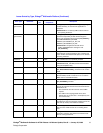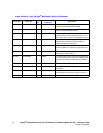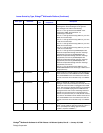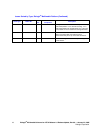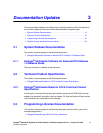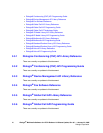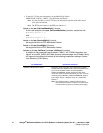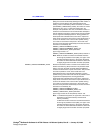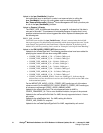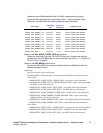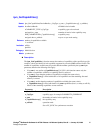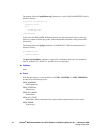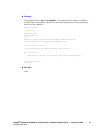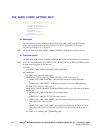
Dialogic
®
Multimedia Software for ATCA Release 1.0 Release Update, Rev 06 — January 23, 2008 23
Dialogic Corporation
PARMCH_LATENCYFRAMEINIT_AUDIO Specifies the amount of Packet Loss Recovery (PLR) latency
(delay) that can be introduced by defining the initial number of
frames that can be buffered. This parameter defines the
starting value for initial latency. When “fixed mode” is enabled
(see PARMCH_LATENCYALG_AUDIO), the number of frames
buffered can grow up to 1.5 times the starting value. For
example, if the parameter value is 6, the maximum number of
frames that can be buffered is 9. The PLR module attempts to
restore packets arriving at the receive end as close as possible
to their original time-stamped positions. Arriving packets are
decomposed into individual frames, each with a unique time
stamp. Each new frame is then stored in a jitter buffer before it
is sent to the decoder. This is done to allow packets arriving
out of order to be inserted in the queue in the correct order.
The size of this jitter buffer is defined by the number of frames
stored and is controlled by the
PARMCH_LATENCYFRAMEINIT_AUDIO,
PARMCH_LATENCYFRAMEMAX_AUDIO, and
PARMCH_LATENCYALG_AUDIO parameters.
Type: Integer. Values: 1 to
PARMCH_LATENCYFRAMEMAX_AUDIO (frames). Default: 6.
Note: While the number of frames to be buffered should be
set as high as possible for best quality, too high a value
will add unnecessary latency to the system. Generally,
the number of frames buffered should be the same size
or slightly larger than the number of frames per packet.
PARMCH_LATENCYFRAMEMAX_AUDIO Defines the maximum number of frames to be buffered in the
Packet Loss Recovery (PLR) frame list. This parameter adds
latency only when the buffer is already filled and additional
frames arrive before there is space in the buffer. This provides
for bursts of packets to arrive, which would have to be
discarded otherwise. The PLR module attempts to restore
packets arriving at the receive end as close as possible to their
original time-stamped positions. Arriving packets are
decomposed into individual frames, each with a unique time
stamp. Each new frame is then stored in a jitter buffer before it
is sent to the decoder. This is done to allow packets arriving
out of order to be inserted in the queue in the correct order.
The size of this jitter buffer is defined by the number of frames
stored and is controlled by the
PARMCH_LATENCYFRAMEINIT_AUDIO,
PARMCH_LATENCYFRAMEMAX_AUDIO, and
PARMCH_LATENCYALG_AUDIO parameters.
Type: Integer. Values: 30 to 200 (frames). Default: 100.
Note: 1. On Windows
®
systems, the upper limit of the value is
dependent on the channel density and the kernel
memory availability.
2. While the number of frames to be buffered should be
set as high as possible for best quality, too high a value
will add unnecessary latency to the system. Generally,
the number of frames buffered should be the same size
or slightly larger than the number of frames per packet.
eIP_PARM Define Description and Values



